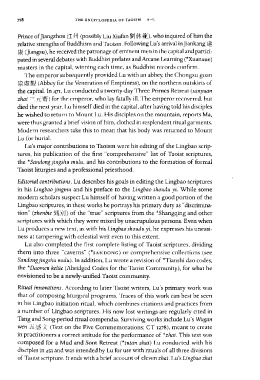Page 760 - The Encyclopedia of Taoism v1_A-L
P. 760
718 THE ENCYCLOPEDIA OF TAOISM A-L
Prince of Jiangzhou iI1+1 (possibly Liu Xiufan rlJ 1* \jiff), who inquired of him the
relative strengths of Buddhism and Taoism. Following Lu's arrival inJiankang 7t
~ (Jiangsu), he received the patronage of eminent men in the capital and partici-
pated in several debates with Buddhist prelates and Arcane Learning (*Xuanxue)
masters in the capital, winning each time, as Buddhist records confirm.
The emperor subsequently provided Lu with an abbey, the Chongxu guan
*' m. 'Jl (Abbey for the Veneration of Emptiness), on the northern outskirts of
the capital. In 471, Lu conducted a twenty-day Three Primes Retreat (sanyuan
zhai ... ~ Jl: J1't) for the emperor, who lay fatally ill. The emperor recovered, but
died the next year. Lu himself died in the capital, after having told his disciples
he wished to return to Mount Lu. His disciples on the mountain, reports Ma,
were thus granted a brief vision of him, clothed in resplendent ritual garments.
Modern researchers take this to mean that his body was returned to Mount
Lu for burial.
Lu's major contributions to Taoism were his editing of the Lingbao scrip·
tures, his publication of the first "comprehensive" list of Taoist scriptures,
the *Sandongjingshu mulu, and his contributions to the formation of formal
Taoist liturgies and a professional priesthood.
Editorial contributions. Lu describes his goals in editing the Lingbao scriptures
in his Lingbao jingmu and his preface to the Lingbao shoudu yi. While some
modern scholars suspect Lu himself of having written a good portion of the
Lingbao scriptures, in these works he portrays his primary duty as "discrimina·
tion" (zhenbie ~ftJJiJ) of the "true" scriptures from the *Shangqing and other
scriptures with which they were mixed by unscrupulous persons. Even when
Lu produces a new text, as with his Lingbao shoudu yi, he expresses his uneasi-
ness at tampering with celestial writ even to this extent.
Lu also completed the first complete listing of Taoist scriptures, dividing
them into three "caverns" (*SANDONG) or comprehensive collections (see
Sandongjingshu mulu). In addition, Lu wrote a revision of *Tianshi dao codes,
the *Daomen keliie (Abridged Codes for the Taoist Community), for what he
envisioned to be a newly-unified Taoist community.
Ritual innovations. According to later Taoist writers, Lu's primary work was
that of composing liturgical programs. Traces of this work can best be seen
in his Lingbao initiation ritual, which combines citations and practices from
a number of Lingbao scriptures. His now·lost writings are regularly cited in
Tang and Song-period ritual compendia. Surviving works include Lu's Wugan
wen JI:!t~;Z (Text on the Five Commemorations; CT 1278), meant to create
in practitioners a correct attitude for the performance of *zhai. This text was
composed for a Mud and Soot Retreat (*tutan zhai) Lu conducted with his
disciples in 453 and was intended by Lu for use with rituals of all three divisions
of Taoist scripture. It ends with a brief account of eleven zhai. Lu's Lingbao zhai

